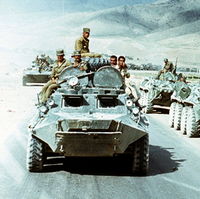Dating the commencement of the U.S. War in Afghanistan from the first entry of American troops into the country on Oct. 7, 2001, the war has now lasted longer than the failed Soviet effort of the 1980s. And at last weekend's NATO summit, the U.S. government committed to continue fighting in Afghanistan at least through 2014, with one senior American official calling even that possible withdrawal date "aspirational."
Opponents of continuing the large-scale, American-led counterinsurgency effort in Afghanistan cite the failure of the Soviet military to suppress the Afghan insurgency in the 1980s as evidence that the United States will encounter similar difficulties today. There are certainly some unfortunate similarities. For example, the Soviet Union tried to transform Afghanistan into a socialist state and viewed the war through its Marxist-Leninist ideology. They therefore never understood the appeal of the Mujahideen opposition, which supported what the Soviets considered reactionary policies. Similarly, some U.S. officials had initially hoped to reconstruct Afghanistan along Western liberal democratic lines in ways that might not have properly reflected local conditions.
Some opponents of the current U.S. military effort favor a complete and rapid American military withdrawal, but most advocate a more-limited American military operation focused on counterterrorism operations. This counterterrorism approach would rely mostly on attacks by U.S. unmanned aerial vehicles against suspected terrorists in Afghanistan and Pakistan as well as limited Special Forces operations in those countries. But U.S. troops would avoid fighting Taliban forces whose goals remained limited to overthrowing the Afghan government.

